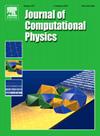A Bayesian extension to FEMU for identification of spatially varying stochastic elastic properties from digital image and volume correlation measurements
IF 3.8
2区 物理与天体物理
Q2 COMPUTER SCIENCE, INTERDISCIPLINARY APPLICATIONS
引用次数: 0
Abstract
We present a Bayesian framework for the identification of stochastic and spatially varying elastic parameters using noisy displacement observations obtained with DIC or DVC trials. Our method is a generalization of identification procedures such as FEMU or I-DIC to materials with spatially varying properties and stochastic mesostructures, where the elasticity tensor is modelled as a parametric non-Gaussian random field. Both the elastic parameters and the parameters of the random field model are identified jointly from the displacement measurement. We formulate the approach as a hierarchical Bayesian PDE-constrained inverse problem and MAP estimates are obtained through gradient based optimization. We resort to an adjoint based formulation and leverage automatic differentiation to derive the parameter sensitivities. We show how modelling unknown parameters with Gaussian Random Fields leads to a natural Bayesian regularization and leverage the use of Whittle-Matérn priors. Covariance parameter estimation is discussed, and we propose an empirical Bayes approach to avoid numerical shortcomings related to a standard hierarchical model. A set of numerical examples is presented to assess the performance of the proposed method, based on synthetic data generated through Matérn Random fields. In particular, we show how data noise is naturally modelled by the Bayesian formulation and impacts spatial covariance of identified parameters.
从数字图像和体积相关测量中识别空间变化随机弹性特性的FEMU贝叶斯扩展
我们提出了一个贝叶斯框架,用于识别随机和空间变化的弹性参数,使用DIC或DVC试验获得的噪声位移观测。我们的方法是将FEMU或I-DIC等识别程序推广到具有空间变化特性和随机细观结构的材料,其中弹性张量被建模为参数非高斯随机场。通过位移测量,同时确定了弹性参数和随机场模型参数。我们将该方法表述为一个层次贝叶斯pde约束逆问题,并通过基于梯度的优化获得MAP估计。我们采用基于伴随的公式,并利用自动微分来推导参数灵敏度。我们展示了如何用高斯随机场建模未知参数导致自然贝叶斯正则化,并利用惠特尔-马塔姆先验。讨论了协方差参数估计,并提出了一种经验贝叶斯方法来避免与标准层次模型相关的数值缺点。最后给出了一组数值算例,以通过mat随机场生成的合成数据为基础,对该方法的性能进行了评估。特别是,我们展示了数据噪声如何自然地由贝叶斯公式建模,并影响识别参数的空间协方差。
本文章由计算机程序翻译,如有差异,请以英文原文为准。
求助全文
约1分钟内获得全文
求助全文
来源期刊

Journal of Computational Physics
物理-计算机:跨学科应用
CiteScore
7.60
自引率
14.60%
发文量
763
审稿时长
5.8 months
期刊介绍:
Journal of Computational Physics thoroughly treats the computational aspects of physical problems, presenting techniques for the numerical solution of mathematical equations arising in all areas of physics. The journal seeks to emphasize methods that cross disciplinary boundaries.
The Journal of Computational Physics also publishes short notes of 4 pages or less (including figures, tables, and references but excluding title pages). Letters to the Editor commenting on articles already published in this Journal will also be considered. Neither notes nor letters should have an abstract.
 求助内容:
求助内容: 应助结果提醒方式:
应助结果提醒方式:


